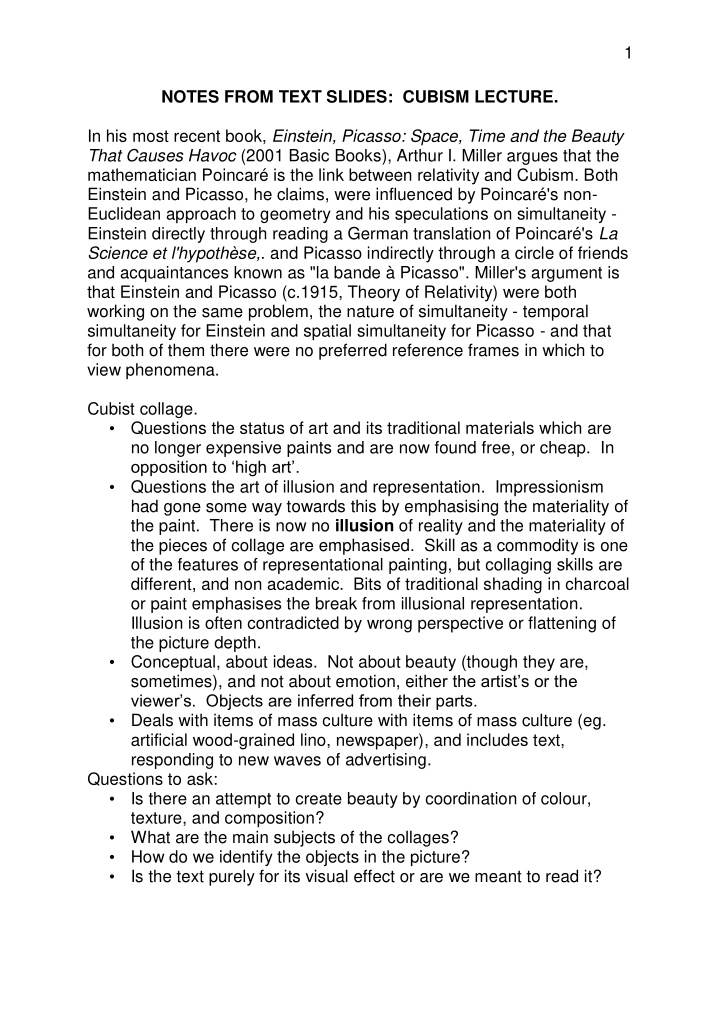



1 NOTES FROM TEXT SLIDES: CUBISM LECTURE. In his most recent book, Einstein, Picasso: Space, Time and the Beauty That Causes Havoc (2001 Basic Books), Arthur I. Miller argues that the mathematician Poincaré is the link between relativity and Cubism. Both Einstein and Picasso, he claims, were influenced by Poincaré's non- Euclidean approach to geometry and his speculations on simultaneity - Einstein directly through reading a German translation of Poincaré's La Science et l'hypothèse, . and Picasso indirectly through a circle of friends and acquaintances known as "la bande à Picasso". Miller's argument is that Einstein and Picasso (c.1915, Theory of Relativity) were both working on the same problem, the nature of simultaneity - temporal simultaneity for Einstein and spatial simultaneity for Picasso - and that for both of them there were no preferred reference frames in which to view phenomena. Cubist collage. • Questions the status of art and its traditional materials which are no longer expensive paints and are now found free, or cheap. In opposition to ‘high art’. • Questions the art of illusion and representation. Impressionism had gone some way towards this by emphasising the materiality of the paint. There is now no illusion of reality and the materiality of the pieces of collage are emphasised. Skill as a commodity is one of the features of representational painting, but collaging skills are different, and non academic. Bits of traditional shading in charcoal or paint emphasises the break from illusional representation. Illusion is often contradicted by wrong perspective or flattening of the picture depth. • Conceptual, about ideas. Not about beauty (though they are, sometimes), and not about emotion, eithe r the artist’s or the viewer’s. Objects are inferred from their parts. • Deals with items of mass culture with items of mass culture (eg. artificial wood-grained lino, newspaper), and includes text, responding to new waves of advertising. Questions to ask: • Is there an attempt to create beauty by coordination of colour, texture, and composition? • What are the main subjects of the collages? • How do we identify the objects in the picture? • Is the text purely for its visual effect or are we meant to read it?
2 • Who is the work intended for (the intended viewer) and what is the social context (advertising, department stores, capitalism, war, poverty, science)? The great cubist experiment of Picasso and Braque before the first world war was never a rejection of the material, visible, ordinary world. It was never a pursuit of the absolute. It was an investigation of reality and of perception. It invented abstract means to achieve representational ends. That's why "pleasure" is the right word for looking at a cubist painting – when we can find time to look at one. The other day I was at Tate Modern and found some time to look at Picasso's 1914 painting Bowl of Fruit, Violin and Bottle. It was good that I was a bit tired at the end of the day and had had a drink, because what makes it hard to cope with cubism is the tension of the museum visitor primed to try and rationally understand what's there. This painting is a world in which to let your imagination ramble: picking on one detail after another, the profile of a musical instrument, globs of grapes hanging in space, the outline of a newspaper, a bulge you realise is a chair leg. Some shapes are outlined, others are touched into conventional three- dimensional life; others are not there at all. But if you can relax your gaze enough and just enjoy the painting long enough, something really amazing happens (and it happens with all cubist masterpieces): a chemistry in your process of perception produces a solid feeling of the things Picasso was looking at, that he was touching with his brain – the fruit, the bottle, the newspaper, the cafe table. A place and a time swim darkly into view; the world is revealed in its majesty. And this is fun. Jonathan Jones, Guardian 26/4/10. Orphism (orphic cubism), Orpheus as poet and artist, mystical. Rooted in Cubism but moving towards bright colours and greater abstraction. Founded by Sonia and Robert Delaunay, friends of Apollinaire, who wrote reviews in their favour, in the early days. In Robert's Eiffel Town Series , the subject is portrayed as if seen from several viewpoints at once; employing the concept of 'mobile perspective' developed by his close friend Metzinger. Later, instead of using muted tones like the Cubists, he would paint with bold, bright colours juxtaposed one next to the other (a concept derived from Neo- Impressionist colour theory, of artists such as Seurat). One of Robert's biggest influences was the chemist Eugène Chevreul. Most famous for discovering margarine, Chevreul delved in dye chemistry as well as the aesthetics of simultaneous contrast of colours: "when complementary colours are juxtaposed, each appears to be more
3 intense than when seen in isolation" and "if there is a perceptible difference in dark-light value between the two colours, then the darker will appear to be even darker" as well as that "all colours present in the field of vision at the same time mutually modify one another in specific ways".
Recommend
More recommend